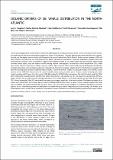Files in this item
Oceanic drivers of sei whale distribution in the North Atlantic
Item metadata
| dc.contributor.author | Houghton, Lucy | |
| dc.contributor.author | Ramirez-Martinez, Nadya | |
| dc.contributor.author | Mikkelsen, Bjarni | |
| dc.contributor.author | Víkingsson, Gísli | |
| dc.contributor.author | Gunnlaugsson, Thorvaldur | |
| dc.contributor.author | Øien, Nils | |
| dc.contributor.author | Hammond, Philip | |
| dc.date.accessioned | 2020-05-15T16:30:03Z | |
| dc.date.available | 2020-05-15T16:30:03Z | |
| dc.date.issued | 2020-05-06 | |
| dc.identifier | 267963828 | |
| dc.identifier | 99a5206d-3f9c-4145-86a0-f1fbc71166e5 | |
| dc.identifier | 85099100091 | |
| dc.identifier.citation | Houghton , L , Ramirez-Martinez , N , Mikkelsen , B , Víkingsson , G , Gunnlaugsson , T , Øien , N & Hammond , P 2020 , ' Oceanic drivers of sei whale distribution in the North Atlantic ' , NAMMCO Scientific Publications , vol. 11 . https://doi.org/10.7557/3.5211 | en |
| dc.identifier.issn | 1560-2206 | |
| dc.identifier.other | RIS: urn:8FC81AB4EA091E37235EF3A4068129F6 | |
| dc.identifier.other | ORCID: /0000-0002-2381-8302/work/74117691 | |
| dc.identifier.uri | https://hdl.handle.net/10023/19951 | |
| dc.description | NRM was supported by Colciencias (Departamento Administrativo de Ciencia, Tecnología e Innovación, Colombia), the University of St Andrews, and NAMMCO. | en |
| dc.description.abstract | This study investigated the oceanic drivers of sei whale (Balaenoptera borealis) distribution in the central and eastern North Atlantic, and explored how distribution may have changed over almost three decades. Cetacean sightings data were available from Icelandic, Faroese and Norwegian surveys conducted throughout the central and eastern North Atlantic during summer between 1987 and 2015. Effective strip half width was estimated from the data to take account of variation in detection probability. Spatially-referenced environmental variables used as predictors in generalised additive models of sei whale relative density included: relief-related variables seabed depth, slope and aspect; monthly-varying physical oceanographic variables sea surface temperature (SST), mixed layer depth, bottom temperature, salinity, and sea surface height anomaly (SSH); and monthly-varying biological oceanographic variables chlorophyll-a concentration and primary productivity. Preliminary analysis considered which month (March-August) in the dynamic oceanographic variables explained most variability in sei whale density. Models including all variables (“full models”) could only be run for 1998-2015 because data for several variables were missing in earlier years. “Simple models" including only relief-related variables and SST were therefore run for 1987-89, and also for 1998-2015 for comparison. The best-fitting full model for 1998-2015 retained the covariates depth, May SST, May bottom temperature, July salinity, July SSH and July primary productivity. Of these, depth, May SST and July SSH were the strongest predictors of sei whale density. In the simple models for both 1987-89 and 1998-2015, depth (especially), May SST and seabed slope were the strongest predictors of sei whale density. The highest densities of sei whales were predicted in the Irminger Sea and over the Charles-Gibbs Fracture Zone; a pattern driven by large negative SSH, deep water (>1500m) and polar-temperate SST (5-12oC). There was some inter-annual variability in predicted distribution and there appears to be a northward expansion in distribution consistent with prey species responding to ocean warming. The models could be used to predict future distribution of sei whales based on future environmental conditions predicted by climate models. | |
| dc.format.extent | 10 | |
| dc.format.extent | 850984 | |
| dc.language.iso | eng | |
| dc.relation.ispartof | NAMMCO Scientific Publications | en |
| dc.subject | Distribution | en |
| dc.subject | Habitat | en |
| dc.subject | Cetacean surveys | en |
| dc.subject | Sei whale | en |
| dc.subject | North Atlantic | en |
| dc.subject | Generalized additive models | en |
| dc.subject | Predictive maps | en |
| dc.subject | QH301 Biology | en |
| dc.subject | DAS | en |
| dc.subject | SDG 13 - Climate Action | en |
| dc.subject.lcc | QH301 | en |
| dc.title | Oceanic drivers of sei whale distribution in the North Atlantic | en |
| dc.type | Journal article | en |
| dc.contributor.institution | University of St Andrews. School of Biology | en |
| dc.contributor.institution | University of St Andrews. Sea Mammal Research Unit | en |
| dc.contributor.institution | University of St Andrews. Scottish Oceans Institute | en |
| dc.contributor.institution | University of St Andrews. Centre for Research into Ecological & Environmental Modelling | en |
| dc.contributor.institution | University of St Andrews. Marine Alliance for Science & Technology Scotland | en |
| dc.identifier.doi | https://doi.org/10.7557/3.5211 | |
| dc.description.status | Peer reviewed | en |
This item appears in the following Collection(s)
Items in the St Andrews Research Repository are protected by copyright, with all rights reserved, unless otherwise indicated.

